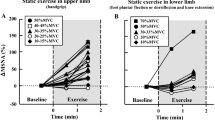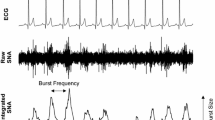Abstract
Yawning is a complex event that depends largely on the autonomic nervous system. Microneurographic techniques were used to study the mechanism involved in yawning. A series of spontaneous yawns displayed by a healthy 39-year-old male offered us the opportunity to study the muscle sympathetic nerve activity (MSNA) during this phenomenon. It was found that 2 s of yawning inhibited the MSNA recorded at the right peroneal nerve in the lateral knee area, while 3 s of slow expiration succeeding a yawn provoked an MSNA discharge. Blood pressure decreased with each slow expiration by 5–6 mmHg, and increased again with the renewed MSNA discharge. We conclude that yawning is associated with a sympathetic suppression that favours a parasympathetic dominance, as indicated by the MSNA and the decrease in blood pressure. The slow expiration following a yawn is associated with a sympathetic activation marked by an MSNA discharge and an increase in blood pressure.
Similar content being viewed by others
References
Askenasy JJM. Is yawning an arousal defense reflex?J Psychol 1989;321:609–621.
Ferrari F, Pelloni F, Giuliani D. Behavioural evidence that different neurochemical mechanisms underly stretching, yawning and penile erection induced in male rats by SND 919, a new selective D2 dopamine receptor agonist.Psychopharmacol (Berlin) 1993;311: 172–176.
Aloe F. Yawning.Arq Neuropsiquiatr 1994;52:273.
Shepherd JT. The lungs as receptor sites for cardiovascular regulation.Circulation 1981;63:1–10.
Eckberg DL, Nerhed C, Wallin BG. Respiratory modulation of muscle sympathetic and vagal cardiac outflow in man.J Physiol (Lond) 1985;365:181–196.
Melis MR, Mauri A, Argiolas A. Apomorphine- and oxytocin-induced penile erection and yawning in intact and castrated male rats: effect of sexual steroids.Neuroendocrinol 1994;59:349–354.
Urba-Holmgren R, Santos A, Holmgren B, Eguibar JR. Two inbred rat sublines that differ in spontaneous yawning behavior also differ in their responses to cholinergic and dopaminergic drugs.Behav Brain Res 1993;56:155–159.
Melis MR, Stancampiano R, Argiolas A. Hippocampal oxytocin mediates apomorphine-induced penile erection and yawning.Pharmacol Biochem Behav 1992;42:61–66.
Bertschy G, Vandel S, Sechter D, Bizouard P. Yawning and sexual excitation under clomipramine. Role of serotoninergic mechanisms.Encephale 1991;17:515–517.
Author information
Authors and Affiliations
Rights and permissions
About this article
Cite this article
Askenasy, J.J.M., Askenasy, N. Inhibition of muscle sympathetic nerve activity during yawning. Clinical Autonomic Research 6, 237–239 (1996). https://doi.org/10.1007/BF02291140
Received:
Accepted:
Issue Date:
DOI: https://doi.org/10.1007/BF02291140




